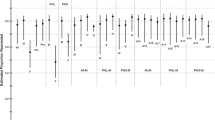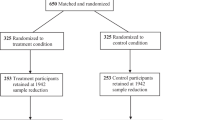Abstract
In this profile, we describe how the Incarcerated Serious and Violent Young Offender Study (ISVYOS) leveraged detailed administrative data to create a prospective longitudinal study. We also discuss the research and policy context at the time the ISVYOS was initiated, its methodology, and what has been learned so far. The ISVYOS includes 1,719 participants who were incarcerated in adolescence and followed through adulthood. Between 1998–2002 (Cohort I) and 2005–2011 (Cohort II), male and female youth were recruited for interviews that measured various risk and protective factors, experiences in custody, and attitudes towards the justice system. Follow-up data include measures of justice system involvement, risk assessment data, and social network data. Participants were an average age of 30.57 (SD = 4.65) as of December 2019. Over 90% of the sample was involved in the adult justice system. So far, research using ISVYOS data has addressed the reliability and validity of measures of psychopathy in adolescence, justice system criminal careers, risk factors for chronic and persistent offending, and the adult offending outcomes of youth involved in serious offenses (e.g., sexual offenses and homicide offense). Inquiries regarding data access should be sent to the first author.


Similar content being viewed by others
Notes
Cohort profile guidelines are listed here: https://www.springer.com/journal/40865/submission-guidelines.
For an example of detailed administrative data in the United States, see Latessa et al. (2015).
The federal government is responsible for creating youth justice legislation, and provinces/territories are responsible for its administration.
References
Ahonen, L., Jennings, W., Loeber, R., & Farrington, D. (2016). The relationship between developmental trajectories of girls’ offending and police charges: Results from the Pittsburgh Girls Study. Journal of Developmental and Life-Course Criminology, 2, 262–274.
Bala, N., Carrington, P., & Roberts, J. (2009). Evaluating the Youth Criminal Justice Act after five years: A qualified success. Canadian Journal of Criminology and Criminal Justice, 51, 131–167.
Bell, S. (2014). Young offenders and juvenile justice: a century after the fact. Nelson.
Borum, R., Bartel, P., & Forth, A. (2002). Manual for the Structured Assessment for Violence Risk in Youth (SAVRY). Consultation version. Tampa: Florida Mental Health Institute, University of South Florida.
Bouchard, M. (2020). Collaboration and boundaries in organized crime: A network perspective. Crime and Justice, 49, 425–469.
Corrado, R., & Markwart, A. (1994). The need to reform the YOA in response to violent young offenders: Confusion, reality or myth. Canadian Journal of Criminology, 36, 343–378.
Corrado, R., & McCuish, E. (2015). The development of early onset, chronic, and versatile offending: The role of fetal alcohol spectrum disorder and mediating factors. International Journal of Child and Adolescent Health, 8, 241.
Corrado, R., Odgers, C., & Cohen, I. (2000). The incarceration of female young offenders: Protection for whom? Canadian Journal of Criminology, 42, 189–207.
Corrado, R., Vincent, G., Hart, S., & Cohen, I. (2004). Predictive validity of the Psychopathy Checklist: Youth Version for general and violent recidivism. Behavioral Sciences & the Law, 22, 5–22.
Cullen, F. (2011). Beyond adolescence-limited criminology: Choosing our future—the American Society of Criminology 2010 Sutherland address. Criminology, 49, 287–330.
Cullen, F. T., Pratt, T. C., & Graham, A. (2019). Why longitudinal research is hurting criminology. The Criminologist, 44(2), 1–7.
Dawson, S., McCuish, E., Hart, S., & Corrado, R. (2012). Critical issues in the assessment of adolescent psychopathy: An illustration using two case studies. International Journal of Forensic Mental Health, 11, 63–79.
DiIulio, J. (1995, December). Moral poverty: the coming of the Superpredators should scare us into wanting to get to the root causes of crime a lot faster. Chicago Tribune, p. 31.
Drefahl, S., Wallace, M., Mussino, E., Aradhya, S., Kolk, M., Brandén, M., & Andersson, G. (2020). A population-based cohort study of socio-demographic risk factors for COVID-19 deaths in Sweden. Nature Communications, 11(1), 1–7.
Farrington, D. (2003). Developmental and life-course criminology: Key theoretical and empirical issues-the 2002 Sutherland Award address. Criminology, 41, 221–225.
Farrington, D. P. (2015). Prospective longitudinal research on the development of offending. Australian & New Zealand Journal of Criminology, 48, 314–335.
Feld, B. (1993). Criminalizing the American juvenile court. Crime and Justice, 17, 197–280.
Forth, A., Kosson, D., & Hare, R. (2003). The Hare Psychopathy Checklist: Youth Version. Multi-Health Systems.
Gottfredson, M., & Hirschi, T. (1990). A general theory of crime. Stanford University Press.
Gress, C. (2010). Revealing research & evaluation. https://www2.gov.bc.ca/assets/gov/law-crime-and-justice/criminal-justice/corrections/research-evaluation/issue-3.pdf.
Gushue, K., McCuish, E. C., & Corrado, R. R. (2021). Developmental offending patterns: Female offending beyond the reference category. Criminal Justice and Behavior, 4, 139–156.
Hirschi, T. (1979). Separate but unequal is better. Journal of Research in Crime and Delinquency, 16, 34–38.
Latessa, E., Lugo, M., Pompoco, A., Sulliva, C., & Wooldredge, J. (2015). Evaluation of Ohio’s prison programs. University of Cincinnati, Cincinnati.
Laub, J., & Sampson, R. (1993). Turning points in the life course: Why change matters to the study of crime. Criminology, 31, 301–325.
Laub, J., & Sampson, R. (2003). Shared beginnings, divergent lives: Delinquent boys to age 70. Harvard University Press.
Le Blanc, M. et al. (1996). Mesures de l’adaptation sociale et personnelle pour les adolescents québécois: manuel et guide d’utilisation [Social and personal adjustment measures for Québec adolescents: User guide and manual] (3rd ed.). Université de Montréal.
Le Blanc, M., & Fréchette, M. (1989). Male criminal activity from childhood through youth: Multilevel and developmental perspective. Springer-Verlag.
Loeber, R., & LeBlanc, M. (1990). Toward a developmental criminology. In M. Tonry & N. Morris (Eds.), Crime and justice (pp. 375–473). University of Chicago Press.
Loughran, T. A., Mulvey, E. P., Schubert, C. A., Fagan, J., Piquero, A. R., & Losoya, S. H. (2009). Estimating a dose-response relationship between length of stay and future recidivism in serious juvenile offenders. Criminology, 47(3), 699–740.
Lussier, P., Corrado, R. R., & McCuish, E. (2016). A criminal career study of the continuity and discontinuity of sex offending during the adolescence-adulthood transition: A prospective longitudinal study of incarcerated youth. Justice Quarterly, 33(7), 1123–1153.
Lussier, P., McCuish, E., & Corrado, R. (2020). Psychopathy and the prospective prediction of adult offending through age 29: revisiting unfulfilled promises of developmental criminology. Journal of Criminal Justice, online first, 1–14.
Lussier, P., McCuish, E., Deslauriers-Varin, N., & Corrado, R. (2017). Crime specialization as a dynamic process? Criminal careers, crime mix, and crime specialization in chronic, serious, and violent offenders. In The Routledge International Handbook of Life-Course Criminology (pp. 112–139). Routledge.
Malakieh, J. (2017). Youth correctional statistics in Canada, 2015/2016. Ottawa, ON. Retrieved from https://www150.statcan.gc.ca/n1/pub/85-002-x/2017001/article/14702-eng.htm on October 19, 2020.
McCuish, E. C. (2020). Seductions of exposure time: The mismeasurement of desistance among persons involved in frequent and serious offending. Canadian Journal of Criminology and Criminal Justice, 62, 29–50.
McCuish, E., Corrado, R., Lussier, P., & Hart, S. (2014). Psychopathic traits and offending trajectories from early adolescence to adulthood. Journal of Criminal Justice, 42, 66–76.
McCuish, E., Bouchard, M., & Corrado, R. (2015a). The search for suitable homicide co-offenders among gang members. Journal of Contemporary Criminal Justice, 31, 319–336.
McCuish, E., Corrado, R., Hart, S., & DeLisi, M. (2015b). The role of symptoms of psychopathy in persistent violence over the criminal career into full adulthood. Journal of Criminal Justice, 43, 345–356.
McCuish, E., Lussier, P., & Corrado, R. (2015c). Examining antisocial behavioral antecedents of juvenile sexual offenders and juvenile non-sexual offenders. Sexual Abuse, 27, 414–438.
McCuish, E., Lussier, P., & Corrado, R. (2016). Criminal careers of juvenile sex and nonsex offenders: Evidence from a prospective longitudinal study. Youth Violence and Juvenile Justice, 14, 199–224.
McCuish, E., Cale, J., & Corrado, R. (2018a). A prospective study of offending patterns of youth homicide offenders into adulthood: An examination of offending trajectories and the crime mix posthomicide. Youth Violence and Juvenile Justice, 16, 18–36.
McCuish, E., Lussier, P., & Corrado, R. (2018b). Incarceration as a turning point? The impact of custody experiences and identity change on community reentry. Journal of Developmental and Life-Course Criminology, 4, 427–448.
McCuish, E., Bouchard, M., Beauregard, E., & Corrado, R. (2019a). A network approach to understanding the structure of core symptoms of psychopathic personality disturbance in adolescent offenders. Journal of Abnormal Child Psychology, 47, 1467–1482.
McCuish, E., Hanniball, K., & Corrado, R. (2019b). The assessment of psychopathic personality disturbance among adolescent male offenders: Interview strategies and recommendations. International Journal of Forensic Mental Health, 18, 35–49.
McCuish, E. C., Lussier, P., & Corrado, R. R. (2021). The life-course of serious and violent youth grown up: A 20-year longitudinal study. Routledge.
Millon, T., & Davis, R. (1993). The Millon Adolescent Personality Inventory and the Millon Adolescent Clinical Inventory. Journal of Counseling and Development, 71, 570–574.
Neil, R., & Sampson, R. (2021). The birth lottery of history: Arrest over the life course of multiple cohorts coming of age, 1995–2018. American Journal of Sociology, 126, 1127–1178.
Ouimet, M. (1993). L’aigle et le castor: étude de la distribution spatiale de la criminalité aux États-Unis et au Canada. Criminologie, 26, 85–102.
Papachristos, A. V., Braga, A. A., Piza, E., & Grossman, L. S. (2015). The company you keep? The spillover effects of gang membership on individual gunshot victimization in a co-offending network. Criminology, 53, 624–649.
Piquero, A. R. (2015). Understanding race/ethnicity differences in offending across the life course: Gaps and opportunities. Journal of Developmental and Life-Course Criminology, 1, 21–32.
Reale, K., McCuish, E., & Corrado, R. (2020). The impact of juvenile sex offending on the adult criminal career. Sexual Abuse, 32(4), 400–422.
Ryu, H., & McCuish, E. C. (2022). Exploring the reciprocal relationship between serious victimization and networks. Canadian Journal of Criminology & Criminal Justice, in press.
Schneider, A. L. (1990). Deterrence and juvenile crime. Springer.
Schubert, C. A., Mulvey, E. P., Steinberg, L., Cauffman, E., Losoya, S. H., Hecker, T., et al. (2004). Operational lessons from the Pathways to Desistance project. Youth Violence and Juvenile Justice, 2, 237–255.
Scott, E., & Steinberg, L. (2009). Rethinking juvenile justice. Harvard University Press.
Statistics Canada. (2013). British Columbia (Code 59) (table). National Household Survey Aboriginal Population Profile. Statistics Canada: Ottawa. www.statcan.gc.ca (accessed February 2020).
Statistics Canada. (2020). Average counts of young persons in provincial and territorial correctional services (Table: 35–10–0003–01 (formerly CANSIM 251–0008)). Retrieved from: https://www150.statcan.gc.ca/t1/tbl1/en/tv.action?pid=3510000301.
Sutherland, E. (1947). Criminology (4th ed.). Lippincott.
Vincent, G., Odgers, C., McCormick, A., & Corrado, R. (2008). The PCL: YV and recidivism in male and female juveniles: A follow-up into young adulthood. International Journal of Law and Psychiatry, 31, 287–296.
Waldenlind, K., Eriksson, J. K., Grewin, B., & Askling, J. (2014). Validation of the rheumatoid arthritis diagnosis in the Swedish National Patient Register: A cohort study from Stockholm County. BMC Musculoskeletal Disorders, 15, 1–6.
Wall-Wieler, E., Roos, L. L., Bolton, J., Brownell, M., Nickel, N. C., & Chateau, D. (2017). Maternal health and social outcomes after having a child taken into care: Population-based longitudinal cohort study using linkable administrative data. Journal of Epidemiology and Community Health, 71, 1145–1151.
Yang, J., McCuish, E., & Corrado, R. (2020). Is the foster care-crime relationship a consequence of exposure? Examining potential moderating factors. Youth Violence and Juvenile Justice, 19, 94–112.
Zylbersztejn, A., Gilbert, R., Hjern, A., Wijlaars, L., & Hardelid, P. (2018). Child mortality in England compared with Sweden: A birth cohort study. The Lancet, 391, 2008–2018.
Author information
Authors and Affiliations
Corresponding author
Additional information
Publisher’s Note
Springer Nature remains neutral with regard to jurisdictional claims in published maps and institutional affiliations.
Rights and permissions
About this article
Cite this article
McCuish, E., Lussier, P. & Corrado, R. Cohort Profile: The Incarcerated Serious and Violent Young Offender Study. J Dev Life Course Criminology 8, 315–335 (2022). https://doi.org/10.1007/s40865-022-00194-y
Received:
Revised:
Accepted:
Published:
Issue Date:
DOI: https://doi.org/10.1007/s40865-022-00194-y




